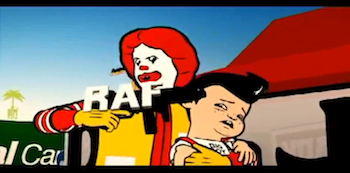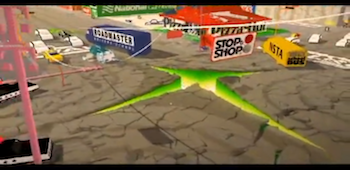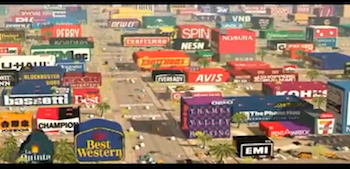Logorama’s Chaotic Critique of Corporate Rule
Esteban del Río / University of San Diego

Ronald McDonald takes Big Boy hostage in Logorama.
When the French film Logorama won the Academy Award for Best Animated Short Film, producer Nicolas Schmerkin remarked in his acceptance speech, “I’m the producer of the film, so I have to thank the 3,000 non-official sponsors that appear in the film. And I have to assure them that no logos were harmed in the making of the project.”1 It was a good joke, considering Schmerkin’s directors made use of fast food icon Ronald McDonald as the film’s antagonist, who sprays machine gun fire, curses, and takes hostages. The statement evoked laughs from the theater audience, made up of writers, producers, directors, actors, and dealmakers who themselves rely rather heavily on advertising, branding, and the commercial endeavors that Logorama apparently lampoons. Perhaps it was an uncomfortable laugh.
The 16-minute short, made by the French design collective H5, takes place in an urban center resembling Los Angeles, made up completely of logotypes. From the opening scene, 3-D computer animation brings corporate symbols to life, as they inhabit every element of the film. Bulbous Michelin men serve as police officers on the trail of a vulgar and dangerous criminal, played by Ronald McDonald. The burger mascot crashes into a diner and takes Big Boy as a child hostage after kicking his playmate, Haribo, in the head. The ensuing SWAT standoff is interrupted when an earthquake upends the city, causing Windows to fall off the Microsoft building and a giant Xbox logo to emerge from the jagged, sunken earth. Ronald McDonald escapes but meets his end as he is run over by the Esso girl and Big Boy as they drive their way out of the earthquake-ravaged city. Oil then drowns the entire scene, cleansed later by a flood of ocean water as the camera zooms out into outer space, with spherical commercial marks approximating the planets and solar system.

The Xbox logo emerges.
The plot is rather pointless, but resembles fragments of the highly commercialized, violent, and dystopic Los Angeles as depicted in films such as Blade Runner (1982), Falling Down (1993), and Pulp Fiction (1994). The film evokes not only Mike Davis’ lucid writings on Los Angeles, but also the televised, real-life violence that unfolds regularly in police chases and hostage standoffs, most notably the drama that unfolded live during the North Hollywood rampage by two gunmen in 1997.2 Often, poverty and ethnic difference make up the cinematic and televisual mise-en-scène of dystopic Los Angeles. In Logorama, commercial marks and mascots fill every frame and do more than drive forward a flimsy plot of violence qua violence. They are the plot. This is clear despite director Francois Alaux’s comment that the brands were secondary to the story, and audiences “have to follow the story and forget the logotypes.”3
Viewed carefully, Logorama reveals its subtle critique of corporations. Ronald McDonald escapes on a motorcycle that is the film logo of Grease 2 (1982), and crashes into giant Weightwatchers package. As an IBM building collapses, its catchphrase loses an “s” to read “Solutions for a mall planet.” During the earthquake, the corporate symbols that fall to earth include Enron, K-Mart, and Freddie Mac, operations marred by scandal, bankruptcy, and government bailout. The logotypes drowning in oil include those from Phillips 66, Chrysler, and a “W” from the George W. Bush reelection campaign of 2004.
[youtube]http://www.youtube.com/watch?v=ksmGnlxXL5s[/youtube]
The satirical potential of Logorama should be clear to most Flow readers, just as it was surely not lost on Academy voters: by subverting the wholesome image of corporate trademarks, filling the screen with familiar commercial logos, and ultimately drowning Logorama’s world in oil, the film critiques consumption in the overdeveloped world and the occupation of public space and public consciousness by brands. However, as critics and commentators have noted, the critique is rather chaotic and slippery, as might be expected with the use of satire. In The New York Times, A.O. Scott describes the film as an “astonishing piece of anti-corporate provocation—unless it is a triumphant sell-out to corporate power,” and continues, “Is it satire or product placement—or both?”4
Part of what is helping to answer this question is the potential trademark violation that has been raised by a number of commentators. If the makers of Logorama were subverting trademark law, then the critical anti-corporate potential of their film is strengthened. Many commentators allude to potential legal problems for the film. Xeni Jardin points out the potential trouble and exciting critical possibilities on the blog Boing Boing, noting that the film was made of “repurposed corporate logo art, all of which is used without permission.”5 Communicate Magazine described Logorama as “a 16-minute send-up of branding that must break records for trademark violations.”6 The transgressive content of the film is buttressed by the renegade and daring production context, which tempts fate by defying intellectual property law.
[youtube]http://www.youtube.com/watch?v=B7URxWTb6hE&feature=related[/youtube]
In media studies, conversations about copyright law and fair use go hand-in-hand. Fair use allows for unauthorized use of copyrighted material for scholarly, critical, artistic, and pedagogical purposes. But trademark law, which protects commercial marks, holds narrow focus on brand dilution and consumer confusion. This narrow focus might lead some to think that commercial marks are off limits, but indeed, there is room to reproduce parts of the culture “owned” as trademarks. Evolving case law seems to make room for Logorama’s appropriation of commercial marks, especially if the film is indeed a satire.7 While the film may be provocative, it is unlikely to provoke lawsuits from trademark holders, especially after securing its position as an Academy Award winner. So, perhaps Logorama is not as daring as it seems.
Nicolas Schmerkin’s coy humor at the Academy Awards, suggesting that the corporations represented in the film were “sponsors,” creates some space to pose further questions about the political function of the film. When asked by Creativity-online.com about whether H5 had heard from any of the brands, co-director Hervé de Crécy replied,
We just received a very funny email from Cash Converter. The main manager of PR of Cash Converter sent an email, “Thank you, I just read an article in Dazed and Confused. We saw our logotype in some pictures and we appreciate you used the logotype in the middle of all the big brands. It matches perfectly with our strategy that you put Cash Converter on the main street, in the heart of the city, thank you so much!”8
This is hardly expressive of any anti-corporate fervor that may drive interest in the film. Complicating matters is that H5 is an industrial artistic collective well-known in France for its artwork in music video and packaging, as well as advertising work for luxury brands such as Cartier and Audi. With a background in advertising and branding, just what are these filmmakers up to?

Logorama’s corporate cityscape.
This quandary, perhaps best expressed above by A.O. Scott, relies on a certain belief about the nature of satire. If audiences read Logorama as satirical, then an anti-corporate message would be difficult to miss. But if audiences read it as straight—as an amazing example of product placement absent of any send-up of corporate domination—then the film triumphs as perhaps the most notable example of a branding sell-out since the latest James Bond film. I would argue that this is unlikely, and that it is much more likely that audiences who read the film as straight would see Ronald McDonald, as depicted like other mascots and logotypes in Logorama, as a horrible spokesperson for McDonalds. The Big Boy character does not reflect well on Bob’s Big Boy Restaurant. A crude, groping, mustachioed Pringles man would be a poor choice to promote potato chips. In other words, it may not matter if audiences get the joke or not, because a “misreading” of the satire would likely also be critical of corporations. We won’t know unless we ask them.
Image Credits:
1. Ronald McDonald takes Big Boy hostage in Logorama.
3. Logorama’s corporate cityscape.
Please feel free to comment.
- Acceptance Speech. Retrieved March 15, 2010, from http://oscar.go.com/nominations/nominees/logorama/3367 [↩]
- See Davis, M. (1990). City of quartz: Excavating the future of Los Angeles. London: Verso. And Davis, M. (1998). Ecology of fear: Los Angeles and the imagination of disaster. New York: Metropolitan [↩]
- Diaz, Ann-Christine (11 September 2010). “H5 Builds the World of Logorama” Retrieved March 12, 2010 from http://creativity-online.com/news/h5-builds-the-world-of-logorama/138951 [↩]
- Scott, A. O. (20 February 2010). “Short on time, long on wit and daring,” Retrieved March 12, 2010 from http://movies.nytimes.com/2010/02/20/movies/20shorts.html?n=Top/Reference/Times%20Topics/Subjects/A/Academy%20Awards%20(Oscars)&scp=4&sq=logorama&st=cse [↩]
- Jardin, X (15 September 2009). “Logorama, animated “city of corporate logos” short by H5, debuts in LA at Flux tonight,” Retrieved 12 March 2010 from http://boingboing.net/2009/09/15/logorama-animated-ci.html [↩]
- “Logos, Brands, and Marquees Bring Logorama an Oscar” (12 March 2010). Retrieved 12 March 2010 from http://communicatemagazine.co.uk/index.php?option=com_content&view=article&id=1105:logos-brands-and-marques-bring-logorama-an-oscar-&catid=1:stories&Itemid=115 [↩]
- See Stabbe, M. H. (2005) “Fair or fowl?” in American Journalism Review 27 (4) 68-72. and McGeveran (2008). “Rethinking trademark fair use” in Iowa Law Review. 51-124. [↩]
- Diaz, Ann-Christine (11 September 2010). “H5 Builds the World of Logorama” Retrieved March 14, 2010 from http://creativity-online.com/news/h5-builds-the-world-of-logorama/138951 [↩]
You make some excellent points.
I originally thought of Logorama as straight up satire, up until it won the Academy. Now with this piece, you got me thinking. Specifically, I began thinking about Shepard Fairey’s Andre the Giant campaign which he has now successfully iconized and marketed to the demographic that subscribes to certain value systems that traditional marketing cannot capture. Tim Stock has written some interesting articles on marketing to the new generation. Mostly he talks about stealth marketing and embedded marketing, but I think Logorama pushes another form of marketing. Speaking just for myself, I had to look up nearly all the icons and logos shown in Logorama as I was unaware of many of the references (avoiding most forms of media does that to a person). But now, those logos have meaning to me in some manner. This is better than any traditional marketer could have hoped for. If the goal is to reach more people, I think Logorama has certainly captured that one missing demographic by appealing to their sense of irony/satire/whatever.
Hey you make some good points in this piece and I enjoyed your insights and writing style. Well done!
Sam – really insightful comments. I think the parallel to Shepard Fairey is an interesting point.
John – Thank you.
When I first saw the film, I found it thrilling. At the same time, I found the plot to be jumbled together to drive the action sequences and allow the logotypes to trip up. Then I thought more about it and wondered if there was room to challenge the idea that the film was critical of consumptions and branding. There is indeed room for such a discussion! But, as I mention in the closing, satire may be more slippery than we imagine when it comes to reception. I’m hoping this piece (and the film) might be useful for pedagogical purposes.
Definitely agree with the assessment presented here. French films are not only reflective of the pragmatic world but it has been looked at and analyzed from a cinematic point of view as well.
Pingback: Selectism | Around the Web | Selectism.com
Pingback: Selectism | Around the Web | Textile Global
Before this won the Academy award I stumbled over a online exhibition of it and emailed the link to a bunch of my friends. We all found the world it created to interesting and refreshing, but thought that the early potential was slowly squandered when no clear viewpoint, characters, or even much of a plot materialized.
But we were all wonder the same thing: how did they get the clearances on all this? Was it fair use? The crime noir aspects do seem to be depicting a fairly amoral universe that is slowly digesting it’s inhabitants — the closest character we come to having a traditional protagonist is easily killed by the raging homicidal Ronald, and “good” and “bad” characters meet their end in equal measure. Was it savvy product placement? We could only hope that McDonald’s would be so bold as to allow their cuddly mascot to be co-opted as a murderous, rampaging lunatic.
But I very much enjoy the distillation of theme and purpose presented here. What do we think to overriding message or island peace at the end after so many of the corporations/cities have been destroyed?
Pingback: American University Intellectual Property Brief » LOGORAMA: The Great Trademark Heist
This is very interesting. I couldn’t watch the videos though, it says the video is not available anymore. I would love to watch it, I’m very curious with it. It’s a good thing that at least you also wrote how the story went. I could imagine how hilarious it is. I think I look for other copies on youtube, if there is any. This is such a short video with a lot of underlying messages and meanings. I haven’t watch it yet, but with this article, I think you guys really did deserve the Academy. Congratulations on that! “No logos were harmed in the making of the project” haha!